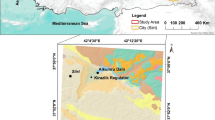Abstract
Subsidence plays a significant role on safety of the mine surface constructions above the underground faces, extraction efficiency, and environment. The prediction of ground surface movements is an important challenge in mining sciences. Subsidence can occur as a result of removing rock in an underground mine. The surface constructions safety to resist subsidence in underground mining depends on mine topography, location, and type of them. The aim of this paper is to investigate the subsidence possibility in an underground mine by establishing the fuzzy membership function. The used subsidence estimation method was based on fuzzy theory. In this regard, using the several α-cuts, the subsidence in definite panel is defined as a fuzzy form. Finally, to show the application of the defined approach in the prediction of an underground mining subsidence based on fuzzy set theory, it was applied for the Tabas coal mine subsidence prediction which located in South Khorasan province of Iran. Results show that the mining area is in an unstable state by considering the critical-factor of safety = 0.75.





Similar content being viewed by others
References
Bauer RA (2008) Planned coal mine subsidence in Illinois: a public information booklet. Illinois State Geological Survey, Department of Natural Resources
Bräuner G (1973) Subsidence due to underground mining: (in two parts). Ground movements and mining damage. US Department of the Interior, Bureau of Mines
Hosseini N (2016) Calculation of periodic roof weighting interval in longwall mining. HampaDanesh Co. Project Final Report, Iran
Li W (1989) Fuzzy models for estimation of surface ground subsidence. In: Proceedings of international symposium on environmental geotechnology, 2nd Envo, USA. 1:317–328
Li WX (1998) Applications of fuzzy mathematics in mining and geotechnical engineering. The Press of Metallurgy Industry, Beijing
Li W (2003a) Fuzzy mathematical method for analysis of movement of Yichang phosphate body. Ind Miner Process 32(4):19–21
Li W (2003b) Fuzzy models of analysis for rock mass displacements due to underground mining in mountain areas. Math Pract Theory 33(2):26–30
Li WX, Mei SH (2003) Fuzzy mathematical method of prediction and analysis on rock mass displacements and instability due to underground mining under river valley. Chin J Rock Mech Eng 20(1):2289–2293
Li W, Mei S, Zai S, Zhao S, Liang X (2006) Fuzzy models for analysis of rock mass displacements due to underground mining in mountainous areas. Int J Rock Mech Min Sci 43(4):503–511
Li WX, Dai LF, Hou XB, Lei W (2007) Fuzzy genetic programming method for analysis of ground movements due to underground mining. Int J Rock Mech Min Sci 44(6):954–961
Li WX, Liu L, Dai LF (2010) Fuzzy probability measures (FPM) based non-symmetric membership function: engineering examples of ground subsidence due to underground mining. Eng Appl Artif Intell 23(3):420–431
Liao CP (1993a) Fuzzy influence function method for calculating mine subsidence in a horizontal seam. Geotech Geol Eng 11(4):235–247
Liao CP (1993b) Fuzzy influence function method for calculating mine subsidence in a horizontal seam. Geotech Geol Eng 11(4):235–247
Rankin W (1988) Ground movements resulting from urban tunnelling: predictions and effects. Eng. Geol 5(1):79–92
Reddish DJ, Whittaker BN (2012) Subsidence: occurrence, prediction and control, vol 56. Elsevier, Amsterdam
Triantaphyllou E (2000) Multi-criteria decision making methods. In: Multi-criteria decision making methods: a comparative study. Springer, Boston, pp. 5–21
Wenxiu L (1987) Fuzzy probability analysis for displacement of rock mass. Sci China Ser B-Chem Biol Agric Med Earth Sci 30(10):1109–1120
Author information
Authors and Affiliations
Corresponding author
Additional information
Publisher's Note
Springer Nature remains neutral with regard to jurisdictional claims in published maps and institutional affiliations.
Rights and permissions
About this article
Cite this article
Hosseini Alaee, N., Mozafari, A., Mirzaee, M. et al. Fuzzy evaluation method for the identification of subsidence susceptibility in an underground mine (case study in Tabas coal mine of Iran). Nat Hazards 99, 797–806 (2019). https://doi.org/10.1007/s11069-019-03774-2
Received:
Accepted:
Published:
Issue Date:
DOI: https://doi.org/10.1007/s11069-019-03774-2




